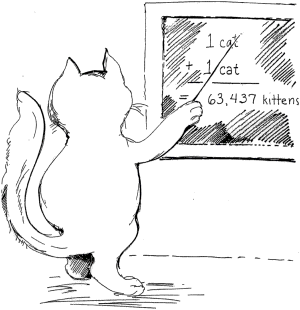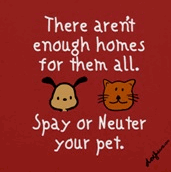
How can we make the biggest difference in animal welfare? The answer may not tug at your heart as the story of an abused puppy or a box of kittens turned in at animal control, but there is no doubt that the biggest bangfor your buck is in spay/neuter programs.
I am always emotionally touched by stories of pets in severe need, and often we try to help those pets. We feel compelled to make a difference for that one dog or cat, and you, our supporters, always rise to the challenge of helping us make it a possibility. I continue to be awed by and grateful for your help.
But some parts of a broad animal welfare approach don't tug at the emotional heartstrings. A low-cost, widespread spay/neuter program is one of those parts. In the past five years, through Casper's Fund, our spay/neuter program, we have subsidized almost 1000 spay/neuter surgeries for Atlanta's pet owners. Our program has prevented thousands of unwanted puppies and kittens from entering the rescue/abuse/stray cycle. And the pets who were fixed are healthier and happier as a result of not constantly dealing with the health and behavior complications that accompany an unfixed pet.
Spay/neuter isn't just good for the pets getting fixed. For an investment of around $75, we can spay or neuter a dog or cat. On average, a cat may have 3 litters a year of 4-5 kittens, and dogs may have 2 litters a year of 6-10 puppies. These are pets that would be listed on Craig's List, given away outside of Walmart, abandoned at vet's offices or surrendered to animal control. Or even worse, many of these puppies and kittens are just dumped in fields or left on the side of the road.

Can you imagine the cost and resources needed to take care of the homeless puppies and kittens into Atlanta's pet population? Your tax dollars pay for the ones that end up animal control. They are caught or trapped, housed and fed for the obligatory holding period, then euthanized. The cost per pet, even for those that stay 5 days and then are killed, is well over $75. For those that are lucky enough to make it to a rescue group, the cost to get them healthy and ready for a new home is $300-$400 minimum. For every $75 investment in spay/neuter, you can save the rescue groups at least $225.
We, as a community of pet lovers and animal welfare advocates, hate the killing that happens in Atlanta shelters. We lament the pet overpopulation problem, and often throw up our hands in frustration, asking "what can we do to really make a difference?"
The answer is very clear - support spay/neuter programs.
Puppy and kitten season is already starting! Together, let's prevent as many pets from entering the homeless pet population as possible.
Can you commit to fixing one in order to save hundreds
**********************************









